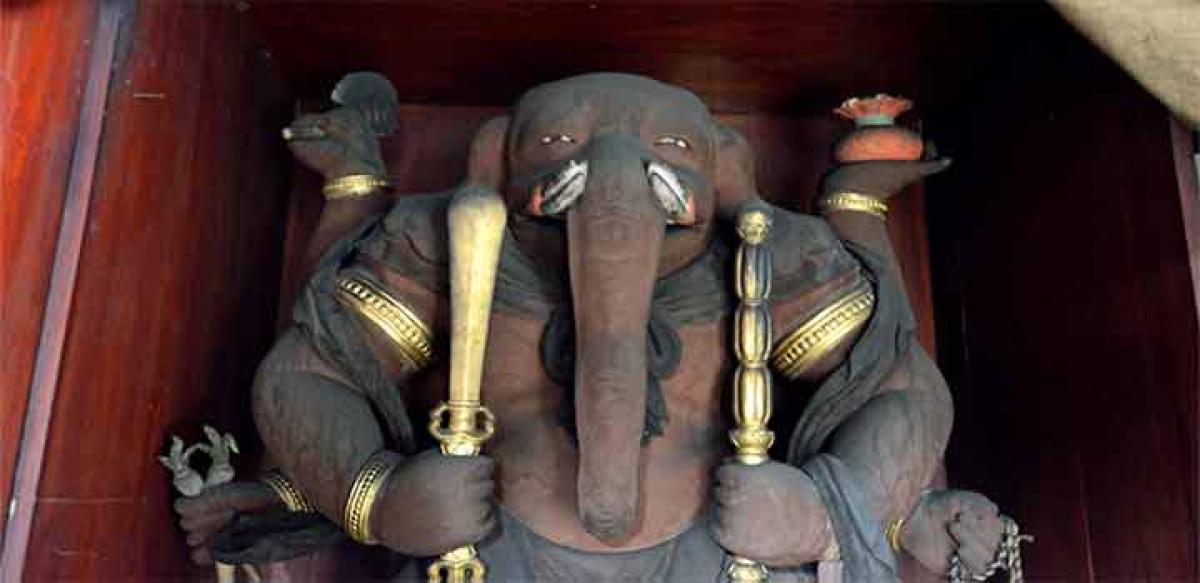Spread of Indian culture in Central Asia

The route was so named because silk was one of the chief mercantile commodities of China. In later times, the same route was used by scholars monks and missionaries.
.jpg)
From the 2nd century B.C. onwards India maintained commercial contact with China, Central Asia, West Asia and the Roman empire. Central Asia is a landmass bound by China, Russia, Tibet, India and Afghanistan.
Traders to and from China regularly crossed the region despite hardships. The route, that was opened by them, later became famous as the Silk Route
The route was so named because silk was one of the chief mercantile commodities of China. In later times, the same route was used by scholars monks and missionaries.
The route served as a great channel for the transmission of cultures of the then known world. The impact of Indian culture was felt strongly in Central Asia.
Among the kingdoms of Central Asia, Kuchi was a very important and flourishing centre of the Indian culture. It was the kingdom where the Silk Route bifurcates and meets at the Dun-huang caves in China again.
Thus, there is the Northern and the Southern Silk Route. The Northern route goes via Samarkand, Kashgarh, Tumshuk, Aksu, Karashahr, Turfan and Hami and the Southern route via Yarkand, Khotan, Keriya, Cherchen and Miran.
Many Chinese and Indian scholars travelled through these routes in search of wisdom and to propagate the philosophy of Buddhism.Cultural exchanges that took place between India and the countries of Central Asia are visible from the discoveries of ancient stupas, temples, monasteries, images and paintings found in all these countries.
Along the route there were resting places for Monks and Missionaries, for pilgrims and merchants and later these became famous centres of Buddhist learning.
Silk and jade, horses and valuables changed hands, but the most lasting treasure that travelled along the route was Buddhism. Thus, the trade route transmitted religion and philosophy, ideas and beliefs, languages and literature, and art and culture.
Khotan was one of the most important outposts. It was on the Southern Silk Route. The history of cultural relationship between India and the kingdom goes back to over two millennia.
Khotan was famous for its silk industry, dance, music, literary pursuits, commercial activities and for gold and jade exports. The history of the Indo-Khotanese relationship is witnessed by a continuous flow of teachers and monks from India to Khotan.
Coins found from the first century AD bear engravings in Chinese on the obverse and Prakrit in Kharosthi script on the reverse providing evidence of a composite culture in Khotan.
A large number of Sanskrit manuscripts, translations and transcriptions of Buddhist texts in Sanskrit were discovered from the monasteries buried in sand.
Spread in East Asia
China
The contact between India and China began around the 2nd Century B.C. Indian culture first entered China with two monk scholars—Kashyapa Martanga and Dharmarakshita who went to China in AD 67 on the invitation of the Chinese Emperor Ming Ti.
After Kashyapa Martanga and Dharmarakshita, there was a continuous flow of scholars from India to China and from China to India. The Chinese were a highly cultured people. They listened to the thrilling stories of the Buddha with great attention.
The Chinese who came in search of wisdom wrote about India and the Indian culture to such an extent that today they are the most important sources of Indian history. Prominent teachers from the Indian Universities and monasteries became famous in China.
For example, a scholar named Bodhidharma went to China from Kanchipuram. He went to Nalanda, studied there and left for China. He carried the philosophy of Yoga with him and popularized the practice of ‘dhyana’, (meditation), which was later known in China as ch’an.
Bodhidharma became such an eminent figure that people began to worship him in China and Japan. The Buddhists philosophy appealed to the Chinese intellectuals because they already had a developed philosophical school in Confucianism.
In the fourth century AD Wei Dynasty came to power in China. Its first Emperor declared Buddhism as the state religion. This gave an impetus to the spread of Buddhism in China. Thousands of Sanskrit books were translated into Chinese.
Braving the hazards of a long and perilous journey they came to visit the land of the Buddha. They stayed in India and collected Buddhist relics and manuscripts related to Buddhism and learnt about it staying at the various educational centres.
With the spread of Buddhism, China began to build cave temples and monastic complexes on a large scale. Colossal images were carved on the rocks and caves were beautifully painted from the inside.
Dun-huang, Yun-kang and Lung-men are among the most famous cave complexes in the world. Indian influences are quite evident on these complexes. The two way traffic of scholars and monks was responsible for cultural contacts and exchange of ideas.
Tibet
Tibet is situated on a plateau to the north of the Himalayas. The people of Tibet are Buddhists. The Tibetan king Naradeva is believed to have sent his minister Thonmi Sambhot accompanied by sixteen outstanding scholars to Magadha where they studied under Indian teachers.
After sometime, Thonmi Sambhot went to Kashmir. It is said that he devised a new script for Tibet in the seventh century on the basis of Indian alphabets of the Brahmi script. Till today, the same script is being used in Tibet. It also influenced the scripts of Mongolia and Manchuria.
It seems Thonmi Sambhot carried with him a number of books from India. On going back to Tibet, he wrote a new grammar for the Tibetans which is said to be based on the Sanskrit grammar written by Panini.
The king was so attracted to the literature brought by him that he devoted four years to study them. He laid the foundation for the translation of Sanskrit books into Tibetan.
As a result, from seventh to seventeenth century, there were continuous efforts on translation. According to this tradition, ninety-six thousand Sanskrit books were translated into Tibetan.
Korea
Korea is situated on the Northeast of China. Korea received Indian cultural elements through China. Sundo was the first Buddhist Monk who entered Korea, carrying a Buddha image and sutras in AD 352.
He was followed by Acharya Mallananda, who reached there in AD 384. In AD 404, an Indian monk built two temples in the Pyongyang city in Korea. He was followed by a number of teachers from India.
They brought philosophy, religion, the art of making images, painting, and metallurgy. Many scholars came to India from Korea in search of knowledge.
They were trained in astronomy, astrology, medicine and in several other fields of knowledge. Monasteries and temples acted as centres of devotion and learning all over Korea.
A large number of Buddhist texts were translated there. The philosophy of ‘dhyana yoga’ reached Korea in the eighth to ninth century AD. The kings and queens, princes and ministers, even warriors began to practise yoga to be brave and fearless.
Out of devotion to wisdom, Buddhist texts were printed by the Koreans in six thousand volumes. Indian scripts had also reached Korea by than.
Japan
The story of Indian culture in Japan is believed to go back to more than fïfteen hundred years. But the earliest historical evidence of Indian culture going to Japan is from AD 552.
At that time, the Korean Emperor sent a Buddhist statue, sutras, instruments for worship, artists, sculptors, painters and architects as gifts for the Japanese Emperor. Soon, Buddhism was given the status of State Religion. Thousands of Japanese became monks and nuns.
Sanskrit was accepted as the sacred language in Japan. Monks were given special training to write the Sanskrit syllables and mantras. The script in which all these are written is known as ‘Shittan’.
Shittan is believed to be Siddham, the script that gives ‘siddhi’ (accomplishment). Even today, there is a keen desire among the Japanese scholars to learn Sanskrit.
As the language of Buddhist scriptures, it is a cementing force between India and Japan. Buddhist sutras, translated into Chinese, were brought to Japan during the time of Prince Shotokutaishi in the seventh century, who was highly impressed by their philosophy.















